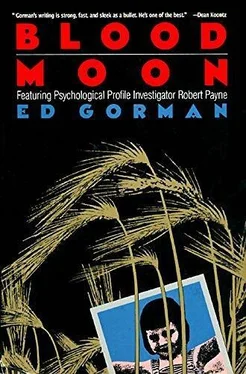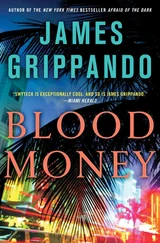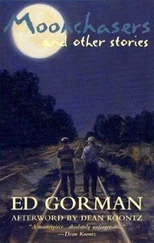I started by going through the national computer files searching for all similar cases. When I had those categorized, I subcategorized them again by — (a) similarities, (b) differences.
I found that four murders with a heavy percentage of similarities had taken place in Iowa over the past three years.
1. Victims were all girls 12–14 years of age.
2. The victims’ necks had been broken.
3. The victims’ bodies were severely mutilated with some weapon on the order of a butcher knife.
4. The victims’ genitalia were cut up and pieces of it placed on their lips.
During the ensuing seven months, I studied the case history of each girl, still looking for similarities.
Because serial killers sometimes tend to murder the same “type” over again — girls with blonde hair, black girls, crippled girls, etc. — I wanted to find one special element that the girls had in common.
One was Jewish, one was Catholic, one was Methodist, one belonged to no particular church. One was involved in sports, one was involved in theater, one was starting her own rock band, one collected dolls. None of them had ever seen the same doctor, dentist, hairdresser. Two wore glasses, two did not. One had been a Dairy Princess contestant, three had not. Three had enjoyed playing video games, one had not.
Then I started making notes on various trips the girls had made over their lives and that was how I learned about New Hope, Iowa.
For different reasons, each girl had visited New Hope shortly before her death.
MONICA KOSTNER had visited there 1-6-90 on an excursion to the Midwestern Pioneer Museum there. She was accompanied by her mother.
SUSAN DOUGHERTY had visited there 11-17-91 to see her aunt, a Mrs. Charles DeWitt. She was accompanied by her father.
MICHELE ROYCE had visited there 7-3-92 and again 8-16-92 to see her grandfather who was dying of throat cancer. She was accompanied by both her parents.
BETTY NOLAN had visited there 8-8-92 to stay overnight with a former classmate, Donna Simpson, who had recently moved there with her parents. Betty took a Greyhound bus from Marion, Iowa, to New Hope. She was unaccompanied both up and back.
After compiling all this data, I spent the next three weeks in New Hope, Iowa looking for a man who fit my profile:
He sounds very organized to me and so I’d say that he is in all likelihood a firstborn son. His father’s work would be stable. But his parental discipline has always been unstable and inconsistent. He has an average or above-average intelligence, but he usually works at jobs below his ability. The FBI profile would show that he’d probably be fascinated with news coverage about himself — his “secret other self” — and might keep a scrapbook of clippings or even a photo album showing his mutilated victims. He is probably between 20 and 40 years of age.
There is a lot more, of course, which I’ll share with you at a later date.
During the course of my investigation in New Hope, Iowa, I met three men who qualify as serious suspects per the profile. They are:
CAL ROBERTS, 36, Caucasian, married, no children. Heavy travel schedule part of his “mission” for the True Light Church, a TV ministry that is always trying to line up new cable outlets. Roberts travels a six-state area calling on local cable companies.
RICHARD McNALLY, 38, Caucasian, father of one daughter. Sells gourmet honey for local beekeeper. Travels the Midwest mostly talking to upscale restaurants. Has been in Des Moines many times.
SAMUEL LODGE, age 38, Caucasian, married, no children. Used to teach art at the U of Iowa. Now gives private lessons and helps his wife run antique shop. Lectures throughout the Midwest.
This is my report up to date. Tomorrow I’m going to rent a room at the River’s Edge Lodge and get into some serious investigation.
I have to say that I don’t have any particular reason to suspect any of the three men I’ve named here. They simply, in broad terms, fit the profile.
As per agreement, I will call you at least twice a week with updates.
Talk to you soon,
Mike Peary
Peary had attached several pages of forms and notes that went into his findings in clinical detail.
What surprises most people about such reports is that they aren’t much concerned with the crime scene itself — the way a detective’s report would be — but with the mind of the killer itself. Most folks on the behavioral-science unit hold degrees in psychology and psychiatry. They speculate on the killer rather than his deeds.
The profiling was identical: you collected and evaluated data, you reconstructed the murders, and you began interpreting the data to give yourself a rough-draft profile, which you then began refining. You needed not only a good, intuitive police mind, you also needed a strong stomach. You learned a great deal from studying autopsy and crime-scene photos and most of them were tough to deal with, no matter how long you’d been at it. After that, you did your profile of the killer to see how it fit previous patterns.
Peary and I had talked about applying for a Small Business Administration loan and setting up shop sometime. If we could have agreed where to put it — he wanted to stay in Des Moines, I voted for Cedar Rapids — we might even have had a chance.
But no longer. All that remained of Peary was a large stack of papers from his very first, unfinished case.
After reading Mike Peary’s letter, I sat in my den with Tasha in my lap and the other two cats next to me. Tash was a tabby, the others of very mixed but very cute heritage.
I sensed that this was going to be the same kind of claustrophobic assignment our own friendly government had often given me. Undercover work with people who were either indifferent to my investigation and therefore uncooperative, or who were downright hostile. Small towns were the same the world over. People tended to be suspicious the moment you started asking questions.
I also thought about Mike Peary. He’d won most of the citations and awards the Bureau gave its agents. He belonged on the front of a Wheaties box — a smart, cautious, fair-minded and brave agent who was determined to help rebuild the Agency’s reputation following the last sad years of J. Edgar Hoover’s time.
Then Mike’s life took an unexpected turn. He’d hinted for years that his marriage was less than wonderful, but over our last lunch he told me that his wife had fallen in love with one of the men she worked with. The man was getting a divorce; so was Mike’s wife.
I started hearing rumors of Mike spending an undue amount of time in Cedar Rapids bars. I phoned him once late last year to see if he wanted to go to an eggnog party some people we knew were throwing. He declined, saying he was pretty busy. Now I knew why he’d been busy. Working for Nora. I asked him about his novel. He’d said that he was stalled temporarily but would be getting back to it when this job was over. He actually sounded reasonably happy. “It’s getting my juices flowing again, Robert. I really may be on to something here.”
“You going to tell me about it?” I’d asked.
He laughed. “You know better than that. I can’t discuss an ongoing investigation with a guy who won’t move to Des Moines. But when it’s all over, we’ll have a steak dinner and I’ll give you every gory detail. And believe me, they really are gory.”
So now here I was all these months later, sitting with his letter in my den, a chill rain starting to pummel the roof and windows, Mike dead and me about to get involved in the same case that at least as Nora told it may well have taken his life.
I picked up a Xerox copy of an article I was going to use in my book about Iowa. The article was about granny medicine in the Midwest, granny medicine being a kind of radical folk medicine practiced on the very early frontier. Next time you think that going to the doctor is so bad, consider some granny remedies (true facts) for health problems back in the early 1800s.
Читать дальше









